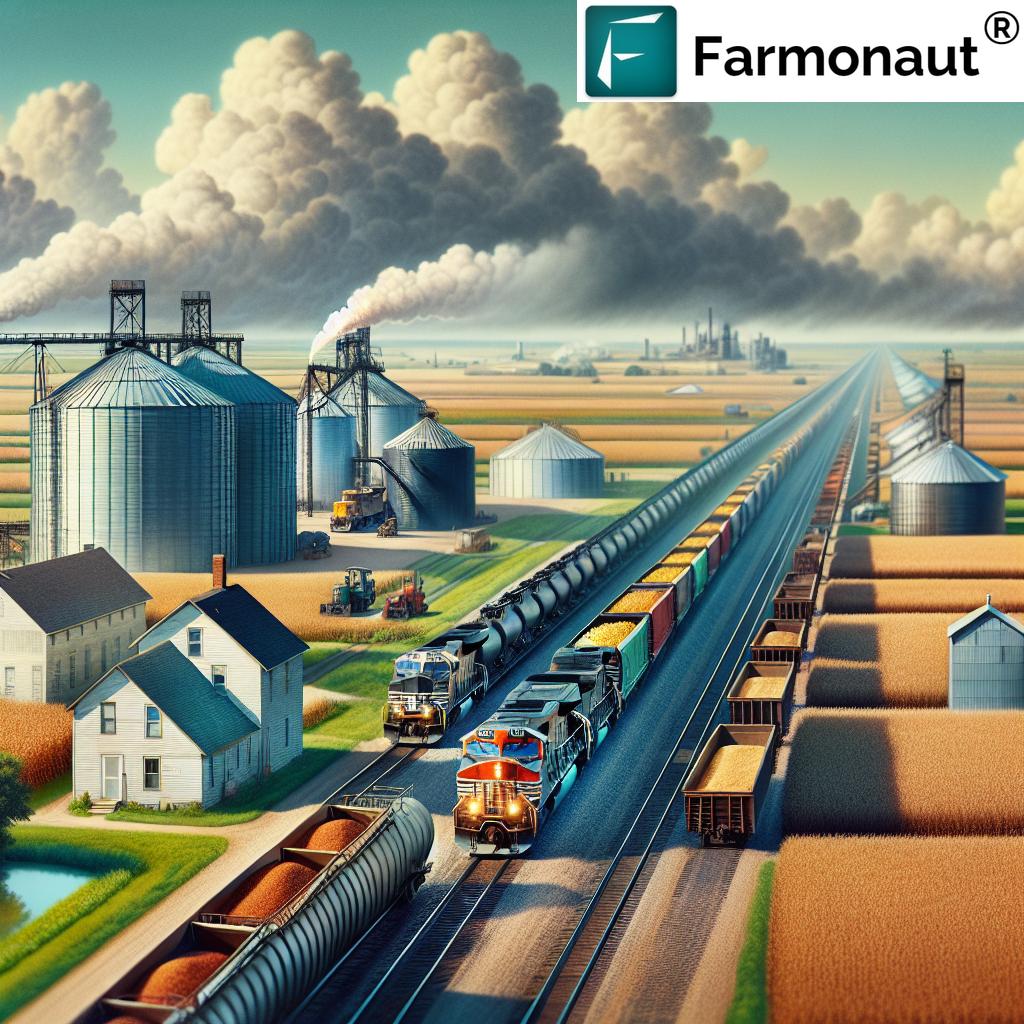Illinois Railroad Revolution: Exploring Chicago’s Freight Network and Historic Short Lines

Welcome to our comprehensive exploration of Illinois’ vibrant railroad landscape, where we’ll journey through the intricate web of short lines and freight networks that have shaped the Prairie State’s transportation history. From the bustling rail yards of Chicago to the rural routes connecting America’s heartland, we’ll uncover the stories behind these iron roads and their vital role in powering the Midwest’s economy.
“Chicago’s Belt Railway handles over 1 million railcars annually, connecting 6 major railroads in the Midwest.”
The Heart of Midwest Rail: Chicago’s Freight Network
At the core of Illinois’ railroad revolution lies Chicago, a city that has long been synonymous with rail transportation. The Windy City’s strategic location has made it the premier railroad hub of North America, where east meets west and major Class I railroads converge. Let’s delve into some of the key players that keep Chicago’s freight moving:
- Belt Railway of Chicago (BRC): Dating back to 1882, the BRC operates 300 miles of track, including 28 main line miles. It serves as a crucial interchange point for six of the seven Class I railroads, with its primary terminal at Clearing Yard.
- Indiana Harbor Belt Railroad (IHB): Established in 1907, the IHB operates 320 miles of track around Chicago’s western edge, extending into northwest Indiana. It’s jointly owned by CSX, Norfolk Southern, and Canadian Pacific.
- Terminal Railroad Association of St. Louis (TRRA): While based in St. Louis, this historic terminal railroad plays a vital role in Illinois’ freight network, handling switching operations in East St. Louis, Madison, and Granite City.
These terminal railroads form the backbone of Chicago’s freight network, ensuring smooth transitions between major carriers and local industries. Their efficiency is crucial for maintaining the flow of goods across the nation.
Historic Short Lines: Preserving Illinois’ Rail Heritage
Illinois boasts a rich tapestry of historic short line railroads, each with its own unique story and contribution to the state’s transportation landscape. These smaller railroads often operate on tracks once owned by larger carriers, preserving rail service to communities and industries that might otherwise lose their rail connections.
One such example is the Chicago, South Shore & South Bend Railroad (CSS). Originally an interurban line, the CSS has evolved into a vital freight carrier serving northern Indiana and the Chicago area. Its history dates back to 1901, and today it continues to operate its original main line under the ownership of Anacostia Rail Holdings.
Another historic gem is the Illinois & Midland Railway (IMRR), which traces its roots to the Pawnee Railroad of 1888. Now a Genesee & Wyoming property, the IMRR operates 97 miles of track, handling a diverse range of commodities including chemicals, coal, and municipal solid waste.
These historic lines not only preserve rail heritage but also play a crucial role in supporting local economies and providing efficient transportation options for Illinois businesses.
Modern Short Lines: Innovating for the Future
While historic short lines continue to serve Illinois, new operators have emerged to meet the changing needs of shippers and adapt to modern logistics challenges. These innovative short lines are leveraging technology and flexible operations to carve out their niche in the freight market.
- Iowa Interstate Railroad (IAIS): From humble beginnings in 1982, the IAIS has grown into a successful regional carrier handling over 110,000 carloads annually. It operates from Chicago to Omaha, showcasing the potential for short lines to expand and thrive.
- Wisconsin & Southern Railroad (WSOR): This Watco-owned regional has breathed new life into once-abandoned branch lines in Wisconsin and northern Illinois. Operating over 700 miles of track, WSOR demonstrates the importance of short lines in preserving rail service and supporting local industries.
These modern short lines are not just preserving rail service; they’re reimagining it for the 21st century. By focusing on customer service, operational efficiency, and strategic partnerships, they’re ensuring that rail remains a competitive transportation option for shippers across Illinois and beyond.

Specialized Services: Meeting Unique Industry Needs
Illinois short lines excel in providing specialized services tailored to specific industries and local needs. These niche operations demonstrate the flexibility and customer-focused approach that set short lines apart from larger carriers.
“Illinois short line railroads transport diverse cargo, including grain, fertilizer, chemicals, and plastics, supporting local industries across 5+ states.”
- Chicago Rail Link (CRL): This OmniTRAX division operates 72 miles along Chicago’s South Side, serving a diverse customer base including BP Amoco, Cargill, and ADM. Its focus on industrial switching and local service highlights the important role short lines play in urban freight networks.
- Decatur & Eastern Illinois Railroad (DREI): Launched in 2018 by Watco, this 182-mile network radiates from Chrisman, Illinois, connecting agricultural and industrial shippers to the national rail network. Its extensive reach demonstrates how short lines can provide comprehensive service across a region.
These specialized carriers showcase the adaptability of short lines in meeting the unique transportation needs of Illinois industries. By offering tailored services and maintaining close relationships with local shippers, they ensure that rail remains a viable and attractive option for freight transportation.
The Economic Impact of Illinois Short Lines
Short line railroads play a crucial role in Illinois’ economy, supporting local industries and providing efficient connections to the national rail network. Their impact extends far beyond the tracks, influencing economic development, job creation, and environmental sustainability.
For example, the Indiana Rail Road (INDR) has grown from its humble beginnings in 1986 to become a vital link for Midwest shippers. With over 500 miles of track and handling more than 200,000 annual carloads, INDR demonstrates the potential for short lines to become major economic drivers.
Similarly, the Toledo, Peoria & Western Railway (TPW), now owned by Genesee & Wyoming, continues to serve as a critical east-west link across Illinois. Its diverse traffic base, including chemicals, machinery, and wind tower components, highlights the role of short lines in supporting both traditional and emerging industries.
By providing cost-effective transportation options and personalized service, Illinois short lines help local businesses remain competitive in the global marketplace. They also play a key role in reducing highway congestion and lowering transportation-related emissions, contributing to a more sustainable freight network.
Challenges and Opportunities for Illinois Short Lines
While Illinois short lines have demonstrated remarkable resilience and adaptability, they face numerous challenges in today’s rapidly evolving transportation landscape. Infrastructure maintenance, regulatory compliance, and competition from trucking are ongoing concerns for many operators.
However, these challenges also present opportunities for innovation and growth. Many short lines are investing in track upgrades, implementing new technologies, and exploring partnerships to enhance their services. For instance, the Chicago, Fort Wayne & Eastern Railroad (CFE), a Genesee & Wyoming property, operates over 300 miles of former Pennsylvania Railroad main line. By maintaining this historic route and adapting it to modern freight needs, CFE exemplifies how short lines can preserve vital infrastructure while meeting contemporary transportation demands.
Furthermore, the increasing focus on supply chain resilience and environmental sustainability presents new opportunities for rail freight. Short lines are well-positioned to capitalize on these trends, offering shippers reliable, fuel-efficient transportation options that can help reduce their carbon footprint.
The Future of Illinois Short Lines
As we look to the future, Illinois short lines are poised to play an increasingly important role in the state’s transportation network. The continued consolidation of Class I railroads and the growing emphasis on local service and customer relationships create a favorable environment for short line growth and innovation.
We anticipate seeing further investment in infrastructure, technology, and service offerings from Illinois short lines. This may include:
- Expanded intermodal services to capture more truck-competitive freight
- Implementation of precision scheduled railroading principles adapted for short line operations
- Increased use of data analytics and IoT technologies to enhance operational efficiency and customer service
- Development of new transload facilities to extend rail access to non-rail served shippers
Moreover, as sustainability becomes an increasingly important factor in transportation decisions, short lines’ inherent efficiency advantages position them well for future growth. We expect to see more shippers turning to rail as they seek to reduce their environmental impact and improve supply chain resilience.
Conclusion: The Vital Role of Short Lines in Illinois’ Rail Revolution
From Chicago’s bustling freight terminals to the rural branch lines serving agricultural communities, Illinois short line railroads form an essential part of the state’s transportation infrastructure. These diverse carriers, ranging from historic routes to modern, technology-driven operations, demonstrate the enduring importance of rail freight in the Midwest economy.
As we’ve explored throughout this article, Illinois short lines offer more than just transportation services. They preserve rail heritage, support local industries, drive economic development, and contribute to a more sustainable freight network. Their ability to adapt to changing market conditions and provide personalized service sets them apart in an increasingly complex logistics landscape.
The future of Illinois’ rail network looks bright, with short lines at the forefront of innovation and customer-focused service. As these railroads continue to evolve and grow, they will undoubtedly play a crucial role in shaping the state’s transportation future, ensuring that Illinois remains at the heart of America’s rail revolution.
FAQ Section
- What is a short line railroad?
A short line railroad is a small or mid-sized railroad company that operates over a relatively short distance. They often connect smaller markets and industries to the larger national rail network operated by Class I railroads. - How many short line railroads are there in Illinois?
While the exact number can fluctuate, Illinois is home to dozens of short line railroads, ranging from small terminal operations to larger regional carriers. - What types of goods do Illinois short lines typically transport?
Illinois short lines transport a wide variety of goods, including agricultural products (grain, corn, soybeans), chemicals, plastics, lumber, steel, and manufactured goods. Some also handle intermodal containers and specialized cargo like wind turbine components. - How do short line railroads contribute to the Illinois economy?
Short lines support local industries by providing cost-effective transportation options, preserving rail service to communities that might otherwise lose it, creating jobs, and attracting new businesses to rail-served areas. They also help reduce highway congestion and transportation-related emissions. - What challenges do Illinois short line railroads face?
Common challenges include maintaining and upgrading infrastructure, competing with trucking, adapting to changing market conditions, and complying with regulatory requirements. However, many short lines are finding innovative ways to overcome these challenges and grow their businesses.
Illinois Short Line Railroads Overview
| Railroad Name | Year Established | Primary Service Area | Main Commodities | Notable Connections | Unique Features |
|---|---|---|---|---|---|
| Illinois Railway | 1997 | Western Chicago suburbs | Aggregates, sand, minerals | BNSF, UP, CN | Operates four disconnected lines totaling 113 miles |
| Indiana Rail Road | 1986 | Illinois-Indiana | Coal, chemicals, intermodal | CSX, NS, CN | Handles over 200,000 carloads annually |
| Iowa Interstate Railroad | 1984 | Illinois-Iowa | Grain, ethanol, intermodal | BNSF, UP, NS | Operates former Rock Island main line |
| Chicago South Shore & South Bend | 1925 | Chicago-South Bend | Steel, chemicals, paper | NS, CSX | Former electric interurban line |
| Toledo, Peoria & Western | 1887 | Illinois-Indiana | Grain, chemicals, machinery | BNSF, NS, CSX | Historic east-west bridge route |
This table provides a snapshot of some key Illinois short line railroads, showcasing the diversity and importance of these carriers in the state’s freight network. From historic lines like the Chicago South Shore & South Bend to more recent operations like the Illinois Railway, these railroads play crucial roles in connecting local industries to the national rail system.
As we’ve explored throughout this article, the Illinois railroad landscape is a vibrant and evolving ecosystem. Short lines continue to adapt and innovate, ensuring that rail remains a competitive and essential part of the state’s transportation infrastructure. Their success stories demonstrate the enduring importance of rail freight in the Midwest and the potential for continued growth and development in the years to come.
For those interested in leveraging technology to optimize agricultural operations, similar to how short lines have innovated in the rail industry, we recommend exploring Farmonaut’s advanced farm management solutions. Their satellite-based crop monitoring and AI-driven advisory systems can help farmers make data-driven decisions to improve productivity and sustainability. Learn more about their services at Farmonaut’s web application.
Additionally, for developers looking to integrate agricultural data into their own applications, Farmonaut offers a comprehensive API. This can be particularly useful for agtech companies or researchers working on innovative solutions for the farming sector. Explore the possibilities at Farmonaut’s API portal.
As we conclude our exploration of Illinois’ railroad revolution, it’s clear that the state’s short lines and freight networks play a vital role in supporting local industries, preserving rail heritage, and driving economic growth. From the bustling terminals of Chicago to the rural branch lines serving agricultural communities, these railroads form an essential part of the Midwest’s transportation infrastructure.
The stories of innovation, adaptation, and perseverance we’ve uncovered demonstrate the resilience and importance of rail freight in today’s complex logistics landscape. As Illinois short lines continue to evolve and grow, they will undoubtedly play a crucial role in shaping the future of transportation in America’s heartland.
We invite you to continue exploring the fascinating world of Illinois railroads and to consider how innovations in transportation and technology are shaping various industries, including agriculture. For those interested in cutting-edge solutions for farm management and crop monitoring, don’t forget to check out Farmonaut’s range of services:
Earn With Farmonaut: Affiliate Program
Earn 20% recurring commission with Farmonaut’s affiliate program by sharing your promo code and helping farmers save 10%. Onboard 10 Elite farmers monthly to earn a minimum of $148,000 annually—start now and grow your income!
















